Sample use cases
Sample use cases
The following use cases demonstrate the various functionalities available in Zowe Explorer.
Working with data sets
Viewing data sets and using multiple filters
-
Expand DATA SETS in the Side Bar, and hover over the profile you want to filter.
-
Click the Search icon.
-
Use the Quick Pick field to select or enter the patterns you want to apply as filters.
The data sets that match your pattern(s) display in the Side Bar.
Tip: To use multiple filters, separate individual entries with a comma. You can append or postpend any filter with an * to indicate a wildcard search. You cannot enter an * as the entire pattern.

Viewing data sets with member filters
-
Expand DATA SETS in the Side Bar, and hover over the profile you want to filter.
-
Click the Search icon.
-
In the Quick Pick field, enter or select a search pattern in the
HLQ.ZZZ.SSS(MEMBERNAME)format to filter out and display the specified member in the Side Bar.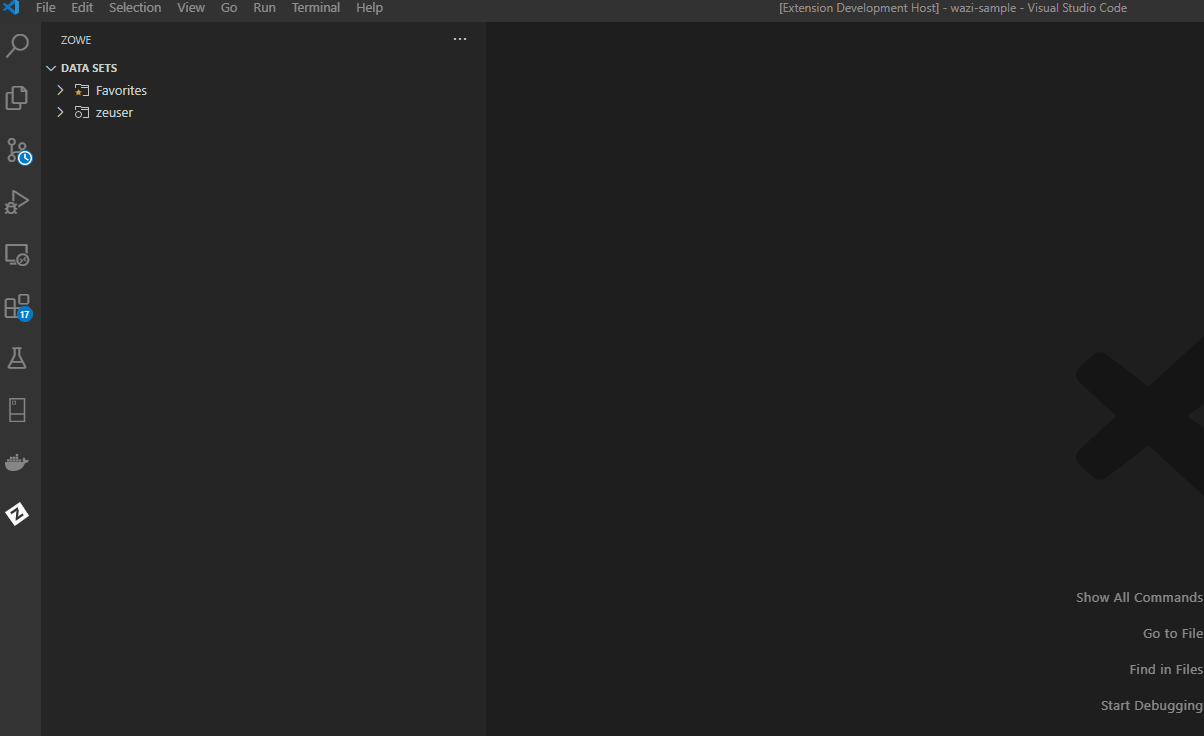
Refreshing the list of data sets
- Hover over DATA SETS in the Side Bar.
- Click the Refresh All icon.
Renaming data sets
-
Expand DATA SETS in the Side Bar, and select the data set you want to rename.
-
Right-click the data set and select the Rename Data Set option.
-
Enter the new name of the data set in the input box.

Copying data set members
-
Expand DATA SETS in the Side Bar, and select the member you want to copy.
-
Right-click the member and select the Copy Member option.
-
Right-click the data set where the member is to be contained and select the Paste Member option.
-
In the input box, enter the name of the copied member.
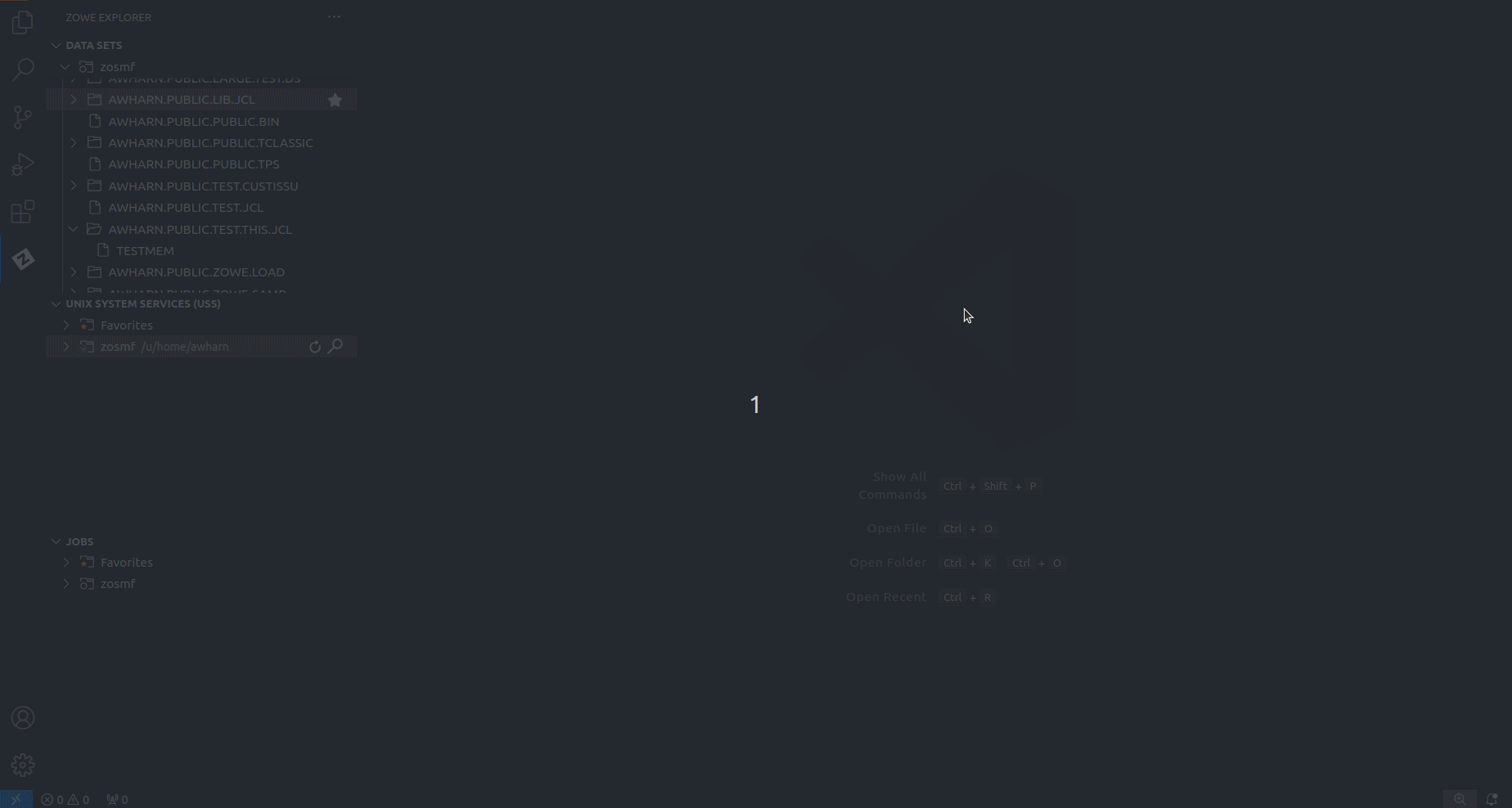
Editing and uploading a data set member
-
Expand DATA SETS in the Side Bar, and select a profile to open it.
-
Open the data set with the member you want to edit.
-
Click on the member name to display it in an Editor tab.
-
Edit the document.
-
Press
Ctrl+SorCommand+Sto save the changes and upload the data set to the mainframe.Note: If someone else has made changes to the data set member while you were editing, you can merge your changes before uploading to the mainframe. See Preventing merge conflicts for more information.
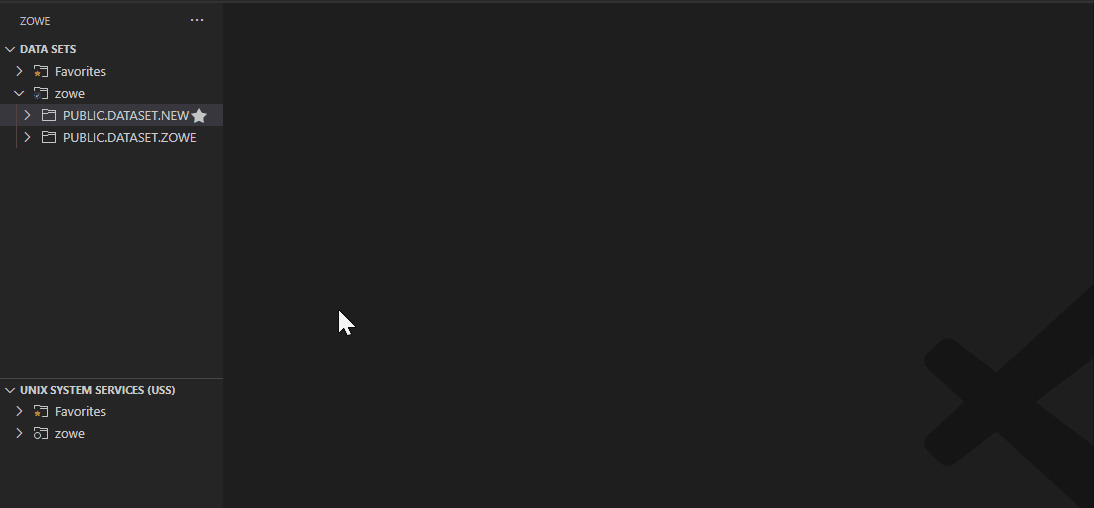
Preventing merge conflicts
-
Expand DATA SETS in the Side Bar, and navigate to the member you want to edit.
-
Edit the document in the Editor tab.
-
Press
Ctrl+SorCommand+Sto save the changes.If the original content in your local version no longer matches the same file in the mainframe, a warning message displays advising the user to compare both versions.
-
If necessary, use the editor tool bar to resolve merge conflicts.
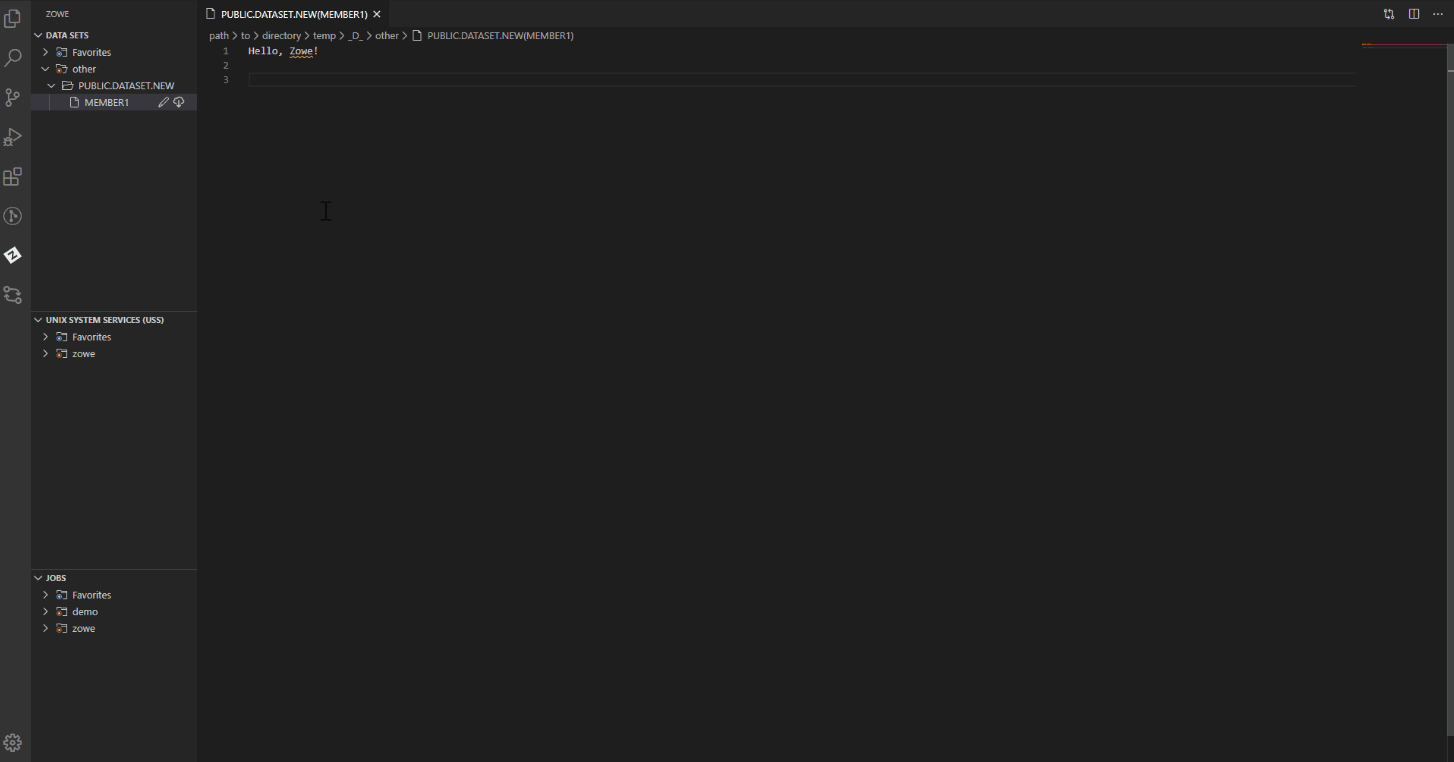
Creating data sets and specifying parameters
-
Expand DATA SETS in the Side Bar.
-
Right-click the profile you want to create a data set with and select Create New Data Set.
-
Enter a name for your data set in the input box and press
Enter. -
From the Quick Pick menu, select the data set type that you want to create and press
Enter. -
Select Edit Attributes in the Quick Pick menu and press
Enter.The attributes list for the data set displays. You can edit the following attributes:
-
Allocation Unit
-
Average Block Length
-
Block Size
-
Data Class
-
Device Type
-
Directory Block
-
Data Set Type
-
Management Class
-
Data Set Name
-
Data Set Organization
-
Primary Space
-
Record Format
-
Record Length
-
Secondary Space
-
Size
-
Storage Class
-
Volume Serial
-
-
Select the attribute you want to edit, provide the value in the input box, and press
Enter. -
(Optional) Edit the parameters of your data set.
-
Select the + Allocate Data Set option to create the data set and list it in the Side Bar.
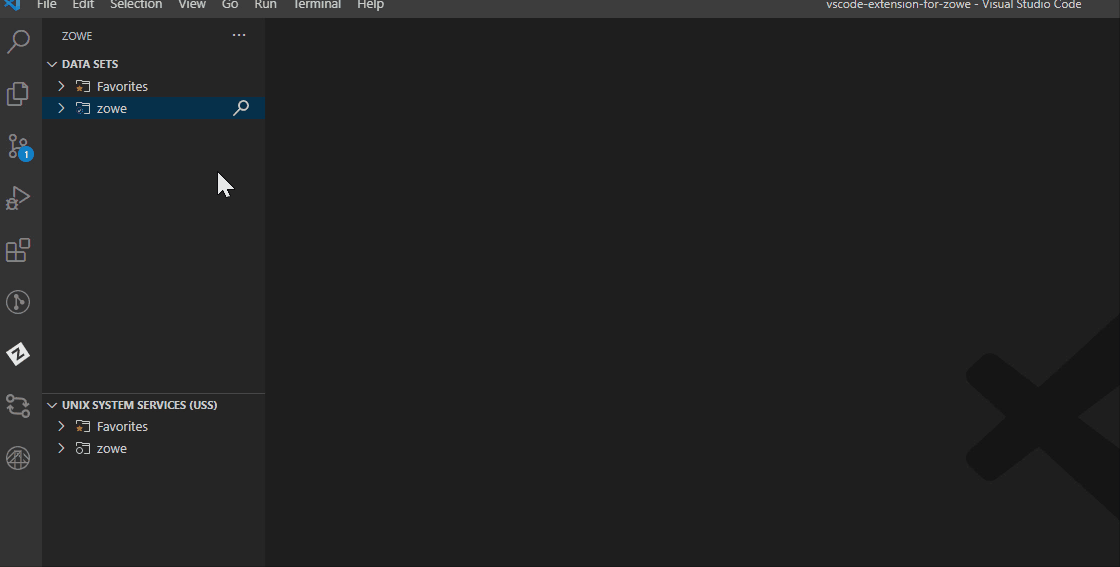
Creating data sets and data set members
-
Expand DATA SETS in the Side Bar.
-
Right-click on the profile where you want to create a data set and select Create New Data Set.
-
Enter a name for your data set in the input box and press
Enter. -
From the Quick Pick menu, select the data set type that you want to create.
-
Select +Allocate Data Set to create your data set.
-
In the Side Bar, right-click your newly-created data set and select Create New Member.
-
Enter a name for your new data set member in the input box and press Enter. The member is created and opened in an Editor tab.
Deleting a data set member and a data set
-
Expand DATA SETS in the Side Bar.
-
Open the profile and data set containing the member you want to delete.
-
Right-click the member and select Delete Member.
-
Confirm the deletion by selecting Delete on the Quick Pick menu.
-
To delete a data set, right-click the data set and select Delete Data Set, then confirm the deletion.
Note: You can delete a data set before you delete its members.
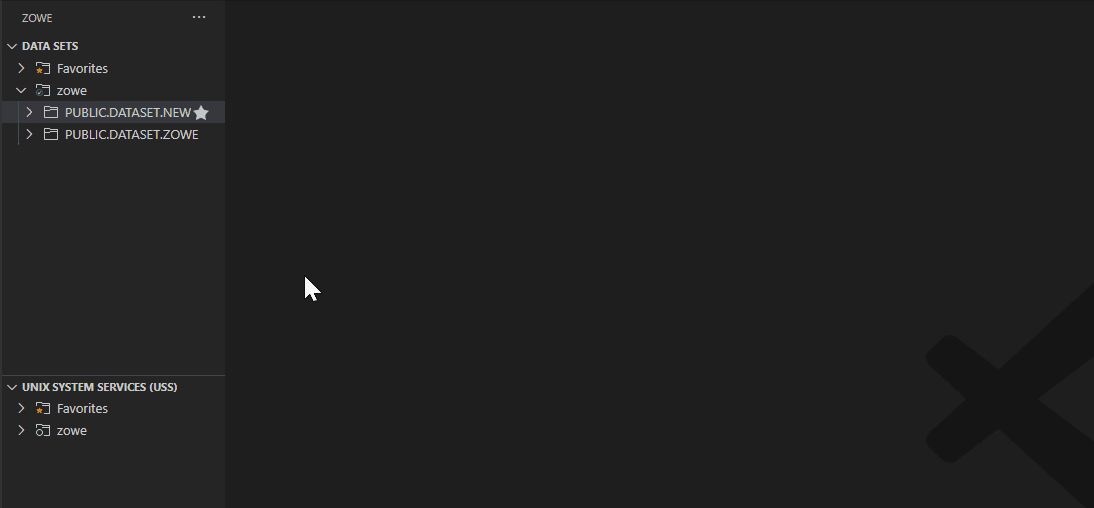
Viewing data set, member attributes
-
Expand DATA SETS in the Side Bar, and click the + icon.
-
Select the Search icon.
-
In the Quick Pick field, enter or select a search pattern to filter search results in the Side Bar.
-
Right-click a data set or member and select the Show Attributes option.
This displays the attributes in an Editor tab.
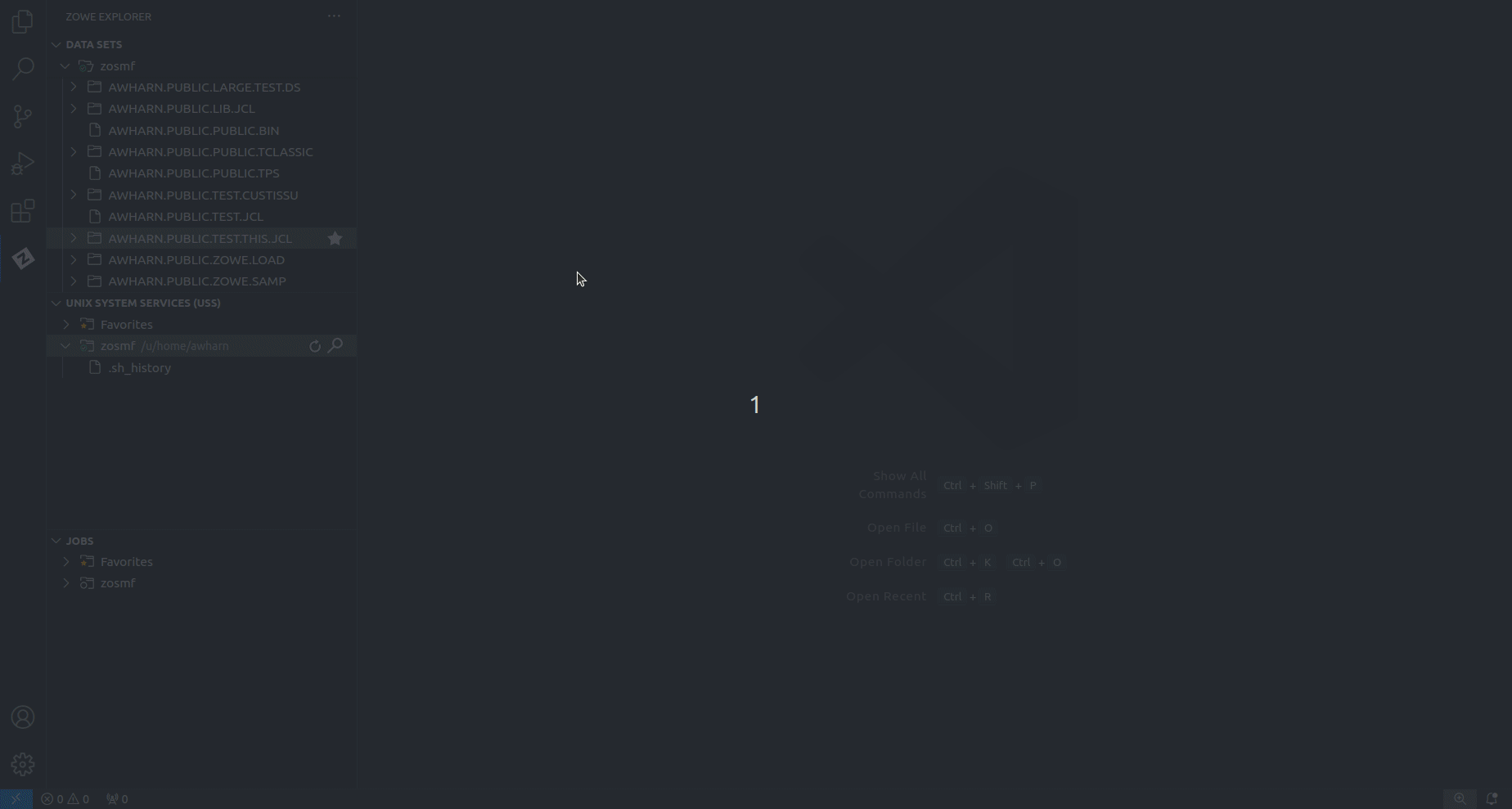
Viewing and accessing multiple profiles simultaneously
-
Expand DATA SETS in the Side Bar, and click the + icon.
-
Select the profiles from the Quick Pick menu to add them to the Side Bar.
-
Click the Search icon for each profile to search and select associated data sets.

Filtering data set members
Filter partitioned data set members in the DATA SETS tree view by Date Modified or User ID.
Filtering all data set members under a specific profile
-
In the DATA SETS tree, click on the Filter icon to the right of a profile, or right-click on a profile and select the Filter PDS members… option.
The filter selection menu appears in the Quick Pick field.
-
Select a filter type from the list of available options:
- Date Modified
- User ID
-
Enter a valid value for the selected filter.
-
Press the
Enterkey to confirm the filter.Expanded data sets display a filtered list of members under the selected profile in the DATA SETS tree.
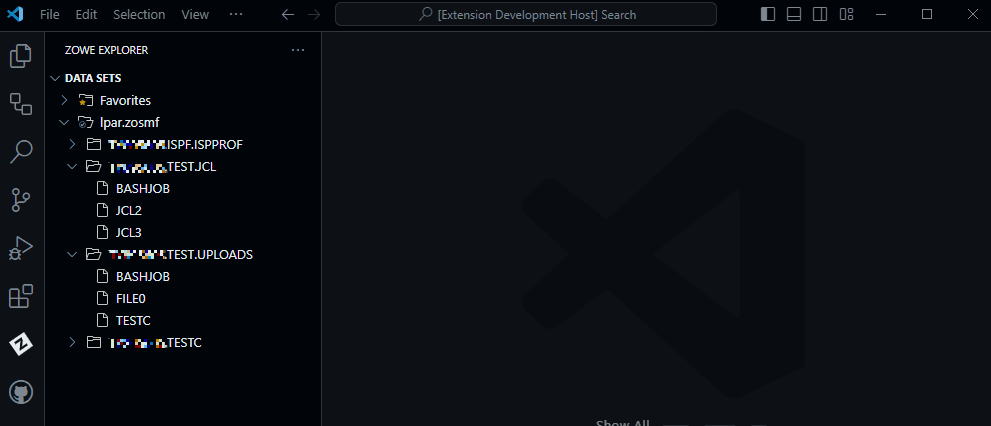
Filtering members for a single data set
-
In the DATA SETS tree, right-click on a data set and select the Filter PDS members… option.
The filter selection menu appears in the Quick Pick field.
-
Select a filter type from the list of available options:
- Date Modified
- User ID
-
Enter a valid value for the selected filter.
-
Press the
Enterkey to confirm the filter. This overrides any profile filter preferences that might be in effect for the single data set.The selected data set displays a filtered list of members in the DATA SETS tree.

Sorting data set members
Sort partitioned data set members in the DATA SETS tree view by member Name, Date Modified, or User ID.
To change the default sort order for data sets, see Modifying the default sort order for data sets and jobs.
Sorting all data set members under a specific profile
-
In the DATA SETS tree, click on the Sort icon to the right of a profile, or right-click on a profile and select the Sort PDS members… option.
The sorting selection menu appears in the Quick Pick field.
-
To change the sorting direction, select the Sort Direction option and select a direction type from the Quick Pick menu.
-
Select a sort type from the list of available options:
- Name
- Date Modified
- User ID
-
Enter a valid value for the selected sort type.
-
Press the
Enterkey to confirm the sort type.Expanded data sets display a sorted list of members under the selected profile in the DATA SETS tree.
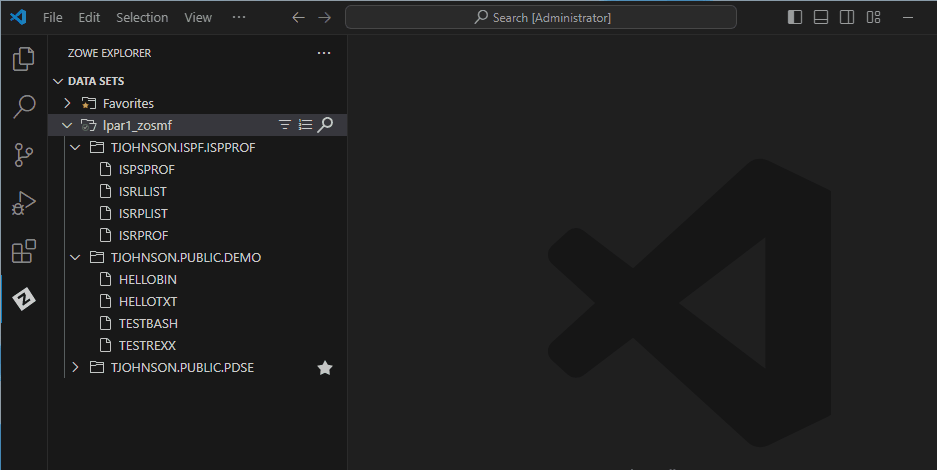
Sorting members for a single data set
-
In the DATA SETS tree, right-click on a data set and select the Sort PDS members… option. The sort selection menu appears in the Quick Pick field.
-
To change the sorting direction, select the Sort Direction option and select a direction type from the Quick Pick menu.
-
Select a sort type from the list of available options:
- Name
- Date Modified
- User ID
-
Enter a valid value for the selected sort type.
-
Press the
Enterkey to confirm the sort type. This overrides any profile sort preferences that might be in effect for the single PDS.The selected data set displays a sorted list of members in the DATA SETS tree.
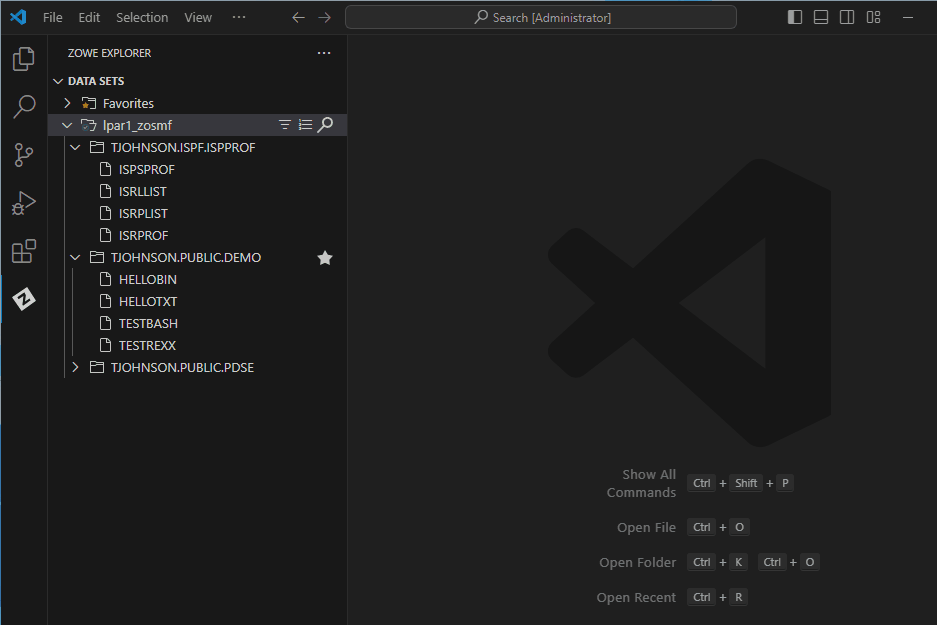
Submiting a JCL
-
Expand DATA SETS in the Side Bar.
-
Select the data set or data set member you want to submit.
-
Right-click the data set or member and select the Submit Job option.
Note: Click on the hyperlink on the notification pop-up message to view the job.
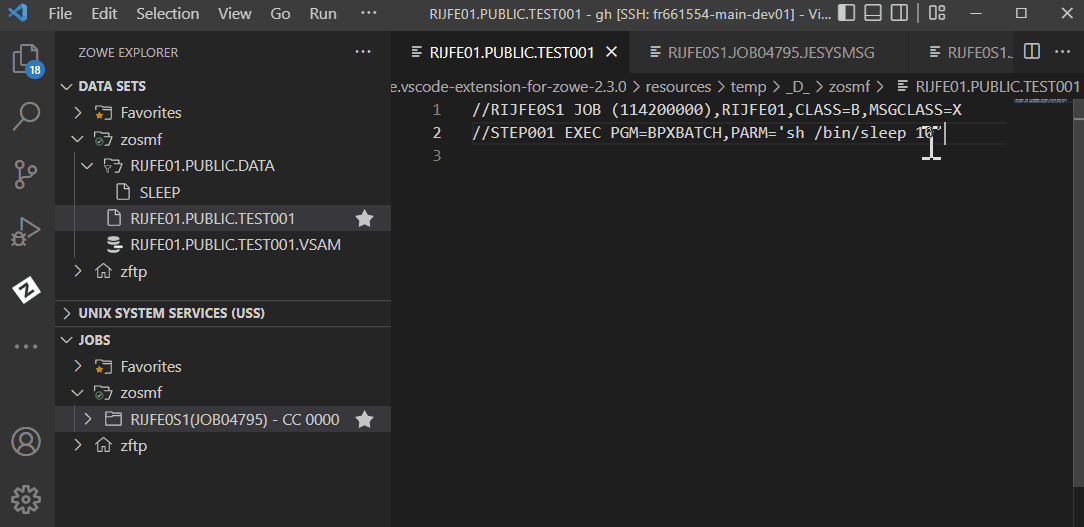
Allocate like
-
Expand DATA SETS in the Side Bar.
-
Right-click a data set and select the Allocate Like (New File with Same Attributes) option.
-
Enter the new data set name in the input box and press
Enter.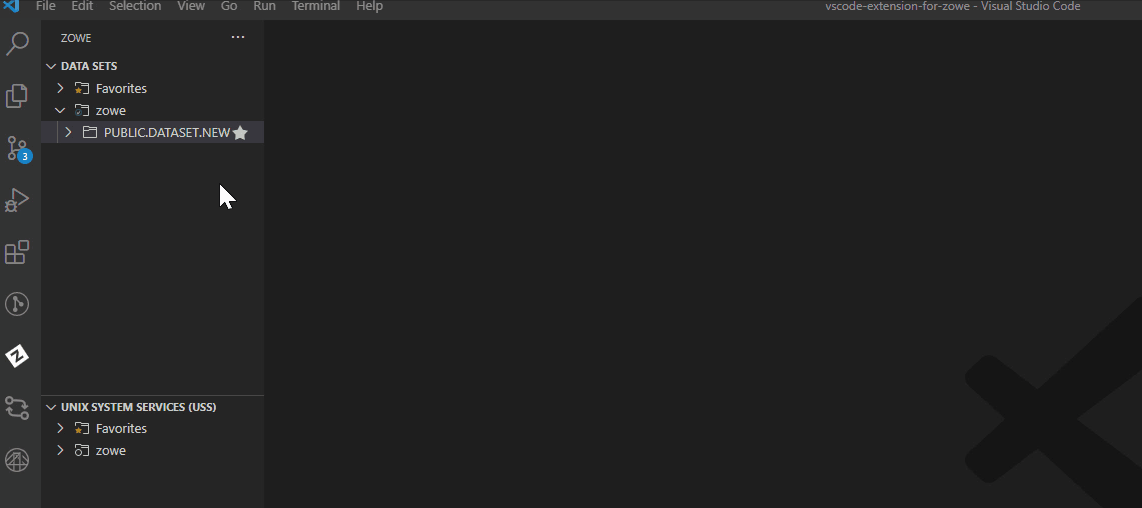
Working with USS files
Viewing Unix System Services (USS) files
-
Expand UNIX SYSTEM SERVICES (USS) in the Side Bar.
-
Hover over the profile you want to search and click the Search icon.
-
In the Quick Pick field, enter or select the path that you want as the root of your displayed tree and press
Enter.All child files and directories of that path display in the Side Bar.
Note: You will not be able to expand directories or files to which you are not authorized.

Refreshing the list of files
-
Hover over UNIX SYSTEM SERVICES (USS) in the Side Bar.
-
Click the Refresh All button.
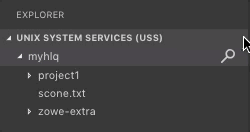
Renaming USS files
-
Expand UNIX SYSTEM SERVICES (USS) in the Side Bar.
-
Select a USS file you want to rename.
-
Right-click the USS file and select the Rename USS file option.
-
In the input box, change the name of the USS file and press
Enter.
Downloading, editing, and uploading existing USS files
-
Expand UNIX SYSTEM SERVICES (USS) in the Side Bar.
-
Navigate to the file you want to download and click on the file name.
This displays the file in an Editor tab.
Note: If you define file associations with syntax coloring, the suffix of your file will be marked up.
-
Edit the document.
-
Press
Ctrl+SorCommand+Sto save the changes and upload the USS file to the mainframe.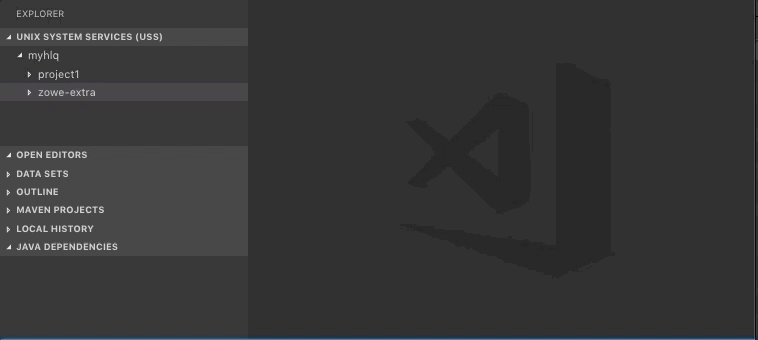
Creating and deleting USS files and directories
Creating a directory
-
Expand UNIX SYSTEM SERVICES (USS) in the Side Bar.
-
Right-click the directory where you want to add the new directory.
-
Select the Create Directory option and enter the directory name in the input box.
-
Press
Enterto create the directory.
Creating a file
-
Expand UNIX SYSTEM SERVICES (USS) in the Side Bar.
-
Right-click the directory to which you want to add the new file.
-
Select the Create File option and enter the file name in the input box.
-
Press
Enterto create the file.
Deleting a file
-
Expand UNIX SYSTEM SERVICES (USS) in the Side Bar.
-
Right-click the file you want to remove.
-
Select the Delete option and click Delete again to confirm and delete the file.
Deleting a directory
-
Expand UNIX SYSTEM SERVICES (USS) in the Side Bar.
-
Right-click the directory you want to remove.
-
Select the Delete button and click Delete again to confirm and delete the directory and all its child files and directories.
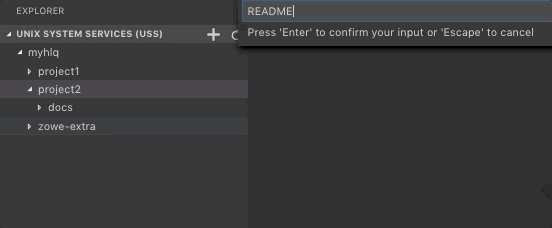
Viewing and accessing multiple USS profiles simultaneously
-
Expand UNIX SYSTEM SERVICES (USS) in the Side Bar, and click the + icon.
-
Select or enter a profile in the Quick Pick drop-down menu to add it to the Side Bar.

Working with jobs
Viewing a job
-
Expand JOBS in the Side Bar.
-
Open a directory with JCL files.
-
Right-click on the JCL file you want to view, and select the Get JCL option.
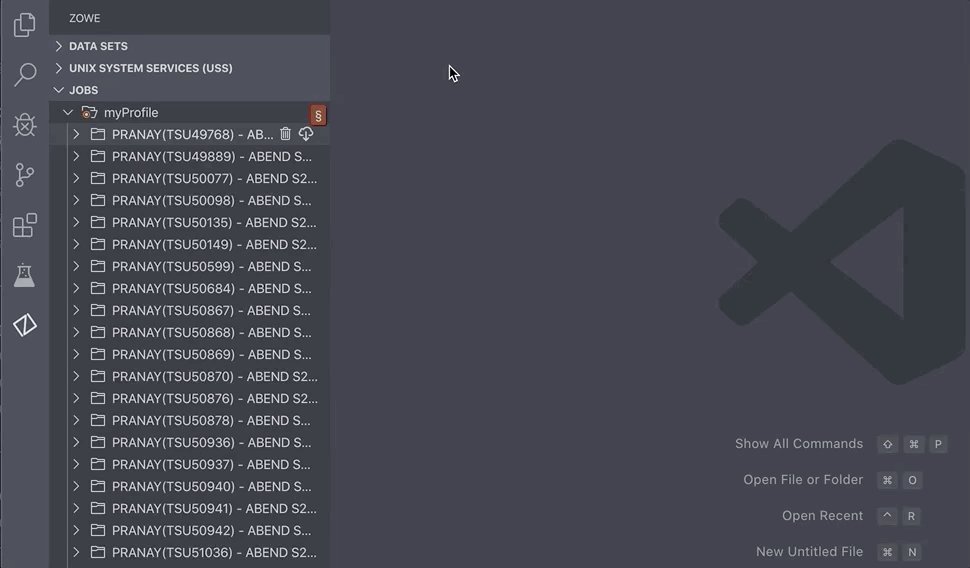
Downloading spool content
-
Expand JOBS in the Side Bar.
-
Open a directory with JCL files.
-
Click the Download icon next to a folder with the spool content.
-
Save the file on your computer.
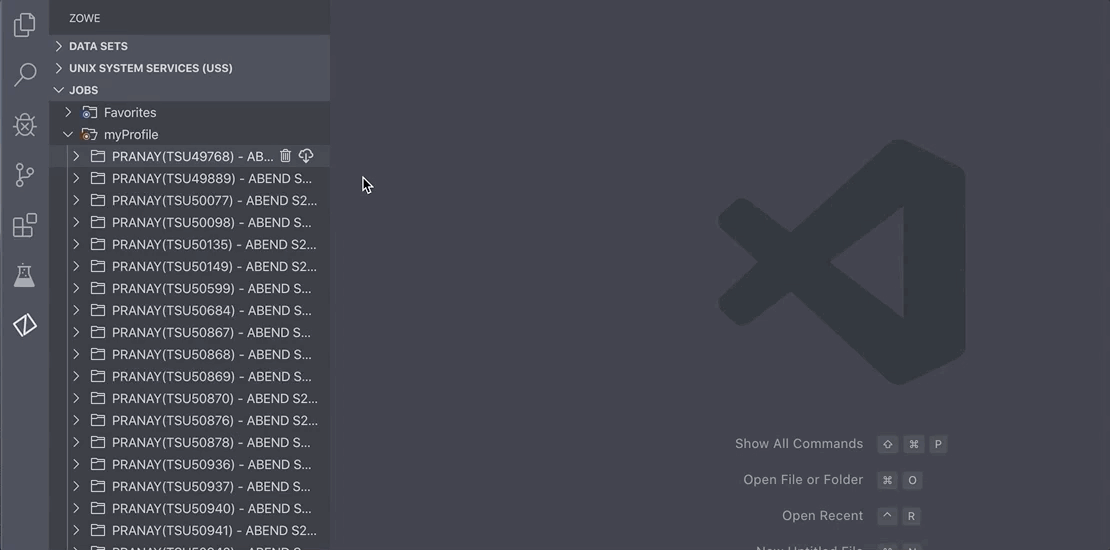
Issuing MVS commands
-
Expand JOBS in the Side Bar.
-
Right-click on your profile and select the Issue MVS Command option.
Alternatively, press the
F1key to open the Command Pallette, then select the Zowe Expolorer: Issue MVS Command option. -
In the Quick Pick field, enter a new command or select a saved command.
-
Press
Enterto execute the command.
Issuing TSO commands
-
Expand JOBS in the Side Bar.
-
Right-click on your profile and select the Issue TSO Command option.
Alternatively, press the
F1key to open the Command Pallette, then select the Zowe Explorer: Issue TSO Command option. -
In the Quick Pick field, enter a new command or select a saved command.
-
Press
Enterto execute the command.The output displays in the Output panel.
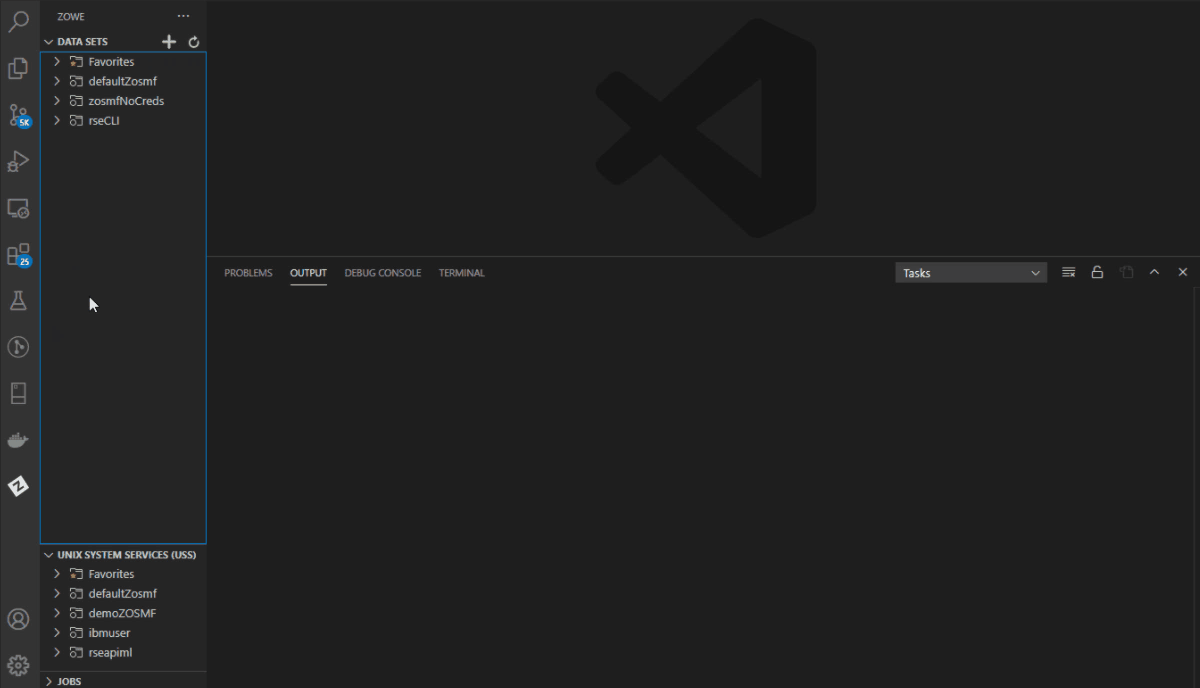
Polling a spool file
Users can periodically refresh a spool file during long-running jobs to get the latest job outputs. This avoids having to close and reopen a spool file to get the latest job outputs.
There are two main ways to poll a spool file — automatically at set intervals or manually on demand.
Defining a default interval for polling spool files
- Click on the Settings icon on the Activity Bar and select Settings.
- In either the User or Workspace tab, click on the Extensions option to open the menu.
- Select Zowe Explorer.
- In the Jobs: Poll Interval field, enter a valid time interval, in milliseconds.
- Value must be greater than or equal to 1000 ms (1 second).
- Press Enter to start the polling action.
Polling a spool file at set intervals
-
Expand JOBS in the Side Bar.
-
Navigate to the spool file by expanding its corresponding profile and job folder.
-
Right click the spool file and select Start Polling.
- Repeat this step with additional spool files to poll multiple files simultaneously.
-
The Poll interval (in ms) for: <spoolfilename> field displays the current interval value.
- The default value is set to 5000 ms.
- Change the value by entering a different number (must be greater than or equal to 1000 ms).
-
Press Enter to confirm the interval time and start the polling action.
The poll request is added to the poller, and the selected spool file is marked with a "P" in the Side Bar and any corresponding Editor tabs.

Stopping spool file polling
-
In the Side Bar, select a spool file that is being polled.
Spool files being polled are marked with a "P" in the Side Bar.
-
Right click the spool file and select Stop Polling.
The poll request is removed from the poller, and the selected spool file is no longer marked with a "P" in the Side Bar and any corresponding Editor tabs.
Polling a spool file manually
A spool file can be polled on demand by using a designated keyboard shortcut.
To manually poll a spool file:
-
In the Side Bar, double click a spool file to open it in an Editor tab.
-
With the spool file in an active tab, press the keyboard shortcut.
- See Configuring the keyboard shortcut for manual polling to set the keyboard shortcut.
The spool file is updated and "Polling..." displays in the bottom status bar.
Configuring the keyboard shortcut for manual polling
-
Click on the Settings icon on the Activity Bar and select Keyboard Shortcuts.
-
Navigate to Zowe Explorer: Poll Content in Active Editor.
-
Select the Edit icon to designate a different keyboard shortcut.
- The default shortcut is the
F5key.
The entered key(s) can be used to activate polling.
- The default shortcut is the